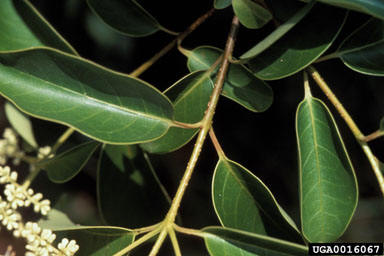
Plant: Japanese privet (Ligustrum japonicum) is a non-native evergreen shrub from Asia.
Identification: Japanese privet is a single plant or thicket-forming shrub with a spreading crown that can grow up to 20 feet tall. Leaves are also evergreen and leathery, opposite, ovate to oblong, from 2 to 4 inches long and 1 to 2 inches wide. Stems are pale green and hairless that eventually turns brownish to reddish in color. Branches are brownish gray with many raised corky dots. The bark is light gray and smooth. Clusters of conical white fragrant flowers appear in the spring (April to June) that will ultimately yield dangling green fruit in the summer. By winter, the fruit will ripen, turning bluish black. This shrub is similar to the Chinese privet in appearance, only larger with wider leaves. It also resembles red tip or photinia (Photinia spp.).
Ecology: It occurs in the same habitats as Chinese privet, but generally not as abundant. Widely planted as an ornamental, this shrub generally escapes cultivation. It invades both lowland and upland habitats. Japanese privet spreads by abundant animal-dispersed seeds and colonizes by root sprouts.
Herbicide Control: Apply anytime from March to September a 60+% active ingredient of triclopyr herbicide (Garlon 4, Remedy, or Tahoe 4E) or a 41% active ingredient of glyphosate herbicide (Accord, Razor, or Roundup Original) as a 3% solution (12 ounces per 3-gal. mix) in water with a surfactant (methylated seed oil, basal oil, or vegetable oil) at a 1% solution (4 ounces per 3-gal. mix) to thoroughly wet all leaves. If safety to surrounding vegetation is not a concern, use a 42+% active ingredient of imazapyr herbicide (Arsenal AC, Vanquish, or Polaris AC) as a 1% solution (4 ounces per 3-gal. mix) in water with a surfactant at a 1% solution. For stems too tall for foliar sprays, apply 60+% active ingredient of triclopyr herbicide as a 20% solution (2.5 quarts per 3-gal. mix) in water with a surfactant (basal oil or vegetable oil) at a 1% solution to young bark as a basal spray from January to February or from May to October. Also, undiluted Pathfinder II can be applied as a basal spray. Or, cut large stems and immediately treat stumps with a 5% solution (20 ounces per 3-gal. mix) of the 42+% active ingredient of imazapyr herbicide or a 10% solution (1 quart per 3-gal. mix) of the active ingredient of hexazinone herbicide (Velpar L) in water with a surfactant at a 1% solution. When safety to surrounding vegetation is desired, carefully treat cut stumps with a 41% active ingredient of glyphosate herbicide or a 44.4% active ingredient of triclopyr herbicide (Garlon 3A or Tahoe 3A) using a 20% solution (5 pints per 3-gal. mix) in water with a surfactant at a 1% solution.
Warning: The active ingredients of imazapyr and hexazinone can damage plants with roots in the treated area. Always read and follow label directions carefully.
Photo and Text Credit: (A Field Guide for the Identification of, A Management Guide for) Invasive Plants in Southern Forests, James H. Miller, USDA Forest Service, 2010, ForestryImages.Org
Additional Resources